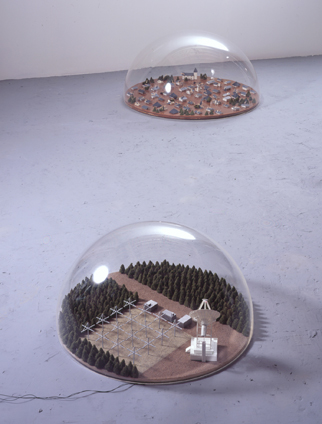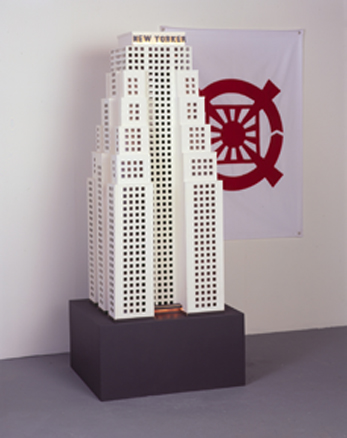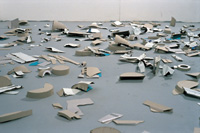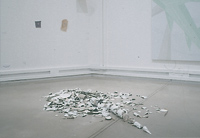



Walking around Matt O'dell's Columbia Space Shuttle, Flight STS-107, 16th January, 2003, (2003) is like treading on eggshells. This is a beautifully crafted model constructed by methodically taking apart a beautifully crafted model made from card and aluminium foil of the Columbia space shuttle. It is developed into its final stages, remade even, in an act of careful scalpeling and bending of pieces of the original made model and placing these pieces in an arrangement on the floor in a considered manner that changes with each showing. This model in situ has a daintiness about it that is imposed upon the viewer as he/she skirts around the vulnerable parts. Laib-like, defined within a strict space, impersonating a collection from far and wide, it is, like Laib, showing a scale of things. In O'dell's case it is a scale of the event, an event as vaporised as pollen. Not as in the pollen-like vaporisation of what is missing - the scale of the destruction that is in the air, and the reason for the influx of images and information received from the various news sources as they do their job, represented here by dust - but the scale of that job itself being done by the news agencies and their own vaporisation of events and hard facts. The lack of facts forensically and surgically gathered together here by O'dell from his own original model are assembled in the likeness of the news event.
What we look at as we tread precariously around the perimeter of this presentation is not the product of the disaster itself but of the news flow. It is the scale of the flow of news information that O'dell identifies and has us walking around. It is always something that is unsaid in the news coverage about an event as the minutes and hours slip by in the left hand corner - how does one put one's finger on this? How does one understand the scale of the information received? The scale of information received is 8' x 24' in this particular configuration. That is the scale that O'dell contrives when confronting the flow of information produced by various news organisations in their restless ambivalence. Despite the absence of facts in this particular news flow, the fact remains, and it is 8' x 24'.
Another fact remains in O'dell's Columbia Space Shuttle, Flight STS-107, 16th January, 2003. This fact is made predominantly of card and aluminium foil. It is a fact that is particularly dry under the circumstances, save a small blinking red LED, the scale of a light on the fascia of a Sony Wega - a signal suggesting remote life and possible continuation of that self-contained 24 hour loop gaining momentum each time it loops back on itself without graspable form or scale. This is the backdrop, in front of which O'dell's work becomes shell-like and quite beautiful as a result. Fragments that do not represent the collection of solid pieces that escaped the vaporising effect of the fireball above the people of Texas, nor the body parts that rained down upon these unwitting folk, but fragments that imagine, as a response to, and in the context of, the information and the aesthetic of its circulation. It is perhaps not after the fact but a matter of fact and it's this matter-of-fact approach to the ambiguous nature of media and its own non-relation to such things that give O'dell's work its tactile quality. These things become card and aluminium foil, paint, vinyl lettering, flashing LED, and small plastic squares readily understood as heat tiles that are as prevalent as the word itself was at the time and get stuck in your shoe no matter how carefully you tread. O'dell has gathered these facts together underfoot.
These fragments placed in the gallery are held together not only by UHU glue, or by the strict conceptual and physical restrictions of the space, but also by the matter-of-factness of the title. The work is contained by this title; it draws all the fragments together specifically. It acts as the fact that presents the fact of O'dell's work. O'dell doubles up to reiterate the tactility of the work as a body-double filmed secretly in some desert and not on the moon at all, finally contained in an unspecified location not found on any map as a result of what it is. It is what it is and named as such. Beyond the title stating what it is we are looking at it tells us the date of what we are looking at. We are looking at 16th January 2003. This date has been stopped.
Here O'dell is complicit in stopping the date. Such a move is almost governmental in its abruptness. It is an abruptness associated with the control of knowledge and information that is often suspected of being complicit with theories cooked up and circulated in the face of insufficient facts available. It is information that is largely unstated, unsubstantiated and ambivalent. It is dependant on a faith that is liable to become bonkers if not carefully monitored. Unlike the news from where they came, these theories and the groups they spawn appear overstated in a demand for recognition. The overstatement attempts perhaps to deny their similarity and relationship to the news and its own odd shapes and phantoms that come and go and are riddled with undermining hearsay. Complicit in this overstatement we need to get involved also, in order to give them shape. Their shape is a product, and scale, of our own involvement but is initiated by their ideologies that we involve ourselves with. It is a self-perpetuating reality that relies on us not bringing our own scale to the table. It is, like the news, dependant on us not being able to put our finger on it. If we do we are mad in the case of conspiracy theories and the non-converted in the case of cults. Either way we have not seen the light. It is like therapy - once we engage in it we have to abide by its rules. O'dell's proximity to his subjects and the hint of risk that he might be converted or short-circuited by his own leads touches the viewer lightly on the shoulder. O'dell invests his time and energy, and like the actual danger of the laser pointer directed out from the dome cutting through the space of the gallery before reaching its target in his Project Haarp, Gekona, Alaska, (2004), or the inclusion of music from The Holy Songbook supplied through headphones to the viewer in his New Yorker/Church of Reunification, (2004) there is an actual danger hovering and connected to his, and therefore our, investment. It is this hint that is also the compulsion lying at the centre of the work, red, blinking and mute, apparently optimistic but maybe not. A point that draws the viewer in as a sign of life but might not allow them to leave quite so easily.
©David Mollin 2005